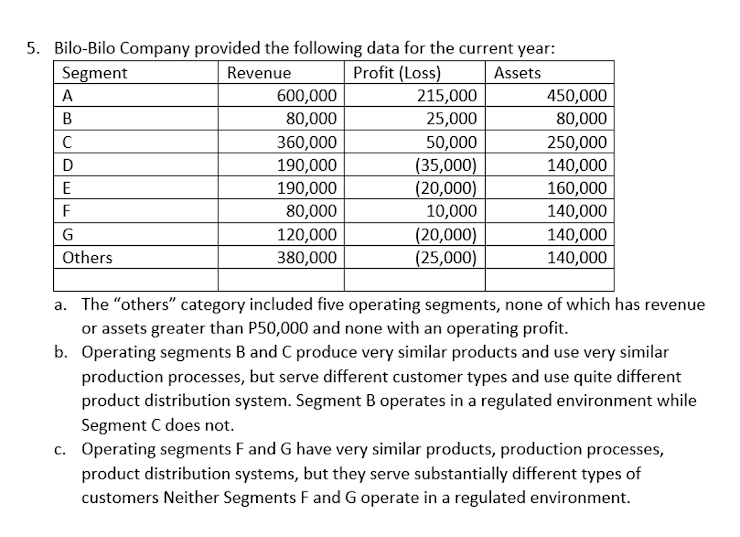5. Bilo-Bilo Company provided the following data for the current year: Segment Revenue Profit (Loss) Assets A 600,000 215,000 450,000 80,000 250,000 140,000 160,000 140,000 80,000 360,000 190,000 B 25,000 50,000 (35,000) (20,000) 10,000 C 190,000 80,000 E F (20,000) (25,000) 140,000 140,000 G 120,000 380,000 Others a. The "others" category included five operating segments, none of which has revenue or assets greater than P50,000 and none with an operating profit. b. Operating segments B and C produce very similar products and use very similar production processes, but serve different customer types and use quite different product distribution system. Segment B operates in a regulated environment while Segment C does not. c. Operating segments F and G have very similar products, production processes, product distribution systems, but they serve substantially different types of customers Neither Segments F and G operate in a regulated environment.
5. Bilo-Bilo Company provided the following data for the current year: Segment Revenue Profit (Loss) Assets A 600,000 215,000 450,000 80,000 250,000 140,000 160,000 140,000 80,000 360,000 190,000 B 25,000 50,000 (35,000) (20,000) 10,000 C 190,000 80,000 E F (20,000) (25,000) 140,000 140,000 G 120,000 380,000 Others a. The "others" category included five operating segments, none of which has revenue or assets greater than P50,000 and none with an operating profit. b. Operating segments B and C produce very similar products and use very similar production processes, but serve different customer types and use quite different product distribution system. Segment B operates in a regulated environment while Segment C does not. c. Operating segments F and G have very similar products, production processes, product distribution systems, but they serve substantially different types of customers Neither Segments F and G operate in a regulated environment.
Survey of Accounting (Accounting I)
8th Edition
ISBN:9781305961883
Author:Carl Warren
Publisher:Carl Warren
Chapter9: Metric-analysis Of Financial Statements
Section: Chapter Questions
Problem 9.23E: Unusual income statement items Assume that the amount of each of the following items is material to...
Related questions
Question
What is the total revenue of the reportable segments after considering the quantitative thresholds but without regard to aggregation criteria?

Transcribed Image Text:5. Bilo-Bilo Company provided the following data for the current year:
Segment
Revenue
Profit (Loss)
Assets
A
600,000
215,000
450,000
80,000
В
80,000
25,000
C
360,000
190,000
50,000
(35,000)
(20,000)
250,000
D
140,000
E
190,000
160,000
F
80,000
10,000
140,000
G
120,000
380,000
(20,000)
(25,000)
140,000
140,000
Others
a. The "others" category included five operating segments, none of which has revenue
or assets greater than P50,000 and none with an operating profit.
b. Operating segments B and C produce very similar products and use very similar
production processes, but serve different customer types and use quite different
product distribution system. Segment B operates in a regulated environment while
Segment C does not.
c. Operating segments F and G have very similar products, production processes,
product distribution systems, but they serve substantially different types of
customers Neither Segments F and G operate in a regulated environment.
Expert Solution
This question has been solved!
Explore an expertly crafted, step-by-step solution for a thorough understanding of key concepts.
Step by step
Solved in 2 steps

Knowledge Booster
Learn more about
Need a deep-dive on the concept behind this application? Look no further. Learn more about this topic, accounting and related others by exploring similar questions and additional content below.Recommended textbooks for you

Survey of Accounting (Accounting I)
Accounting
ISBN:
9781305961883
Author:
Carl Warren
Publisher:
Cengage Learning

Survey of Accounting (Accounting I)
Accounting
ISBN:
9781305961883
Author:
Carl Warren
Publisher:
Cengage Learning